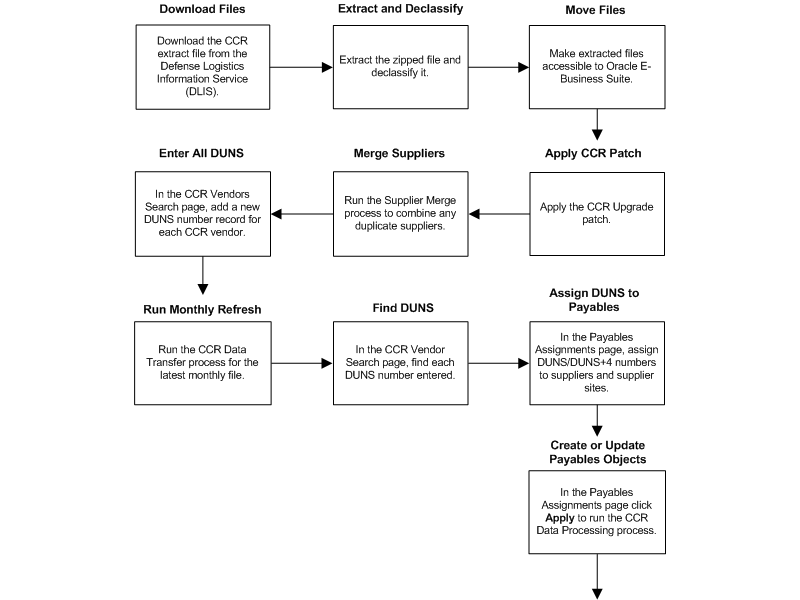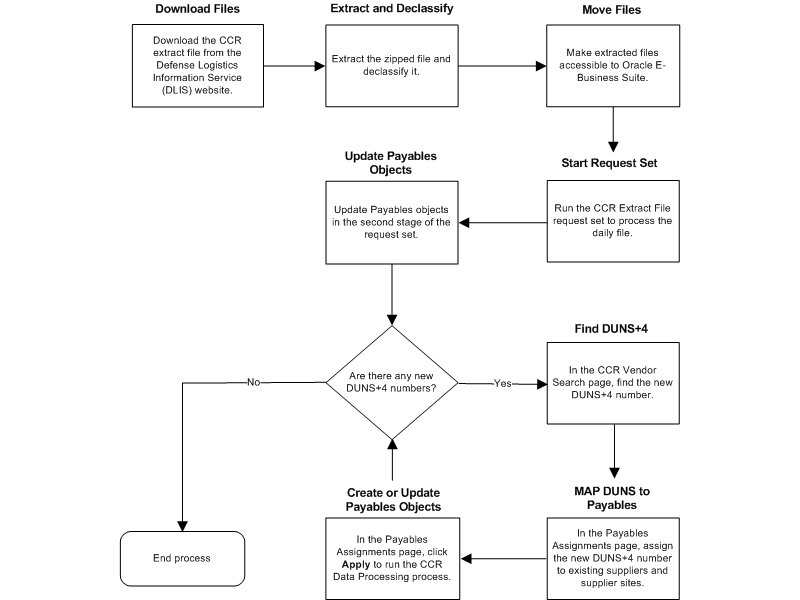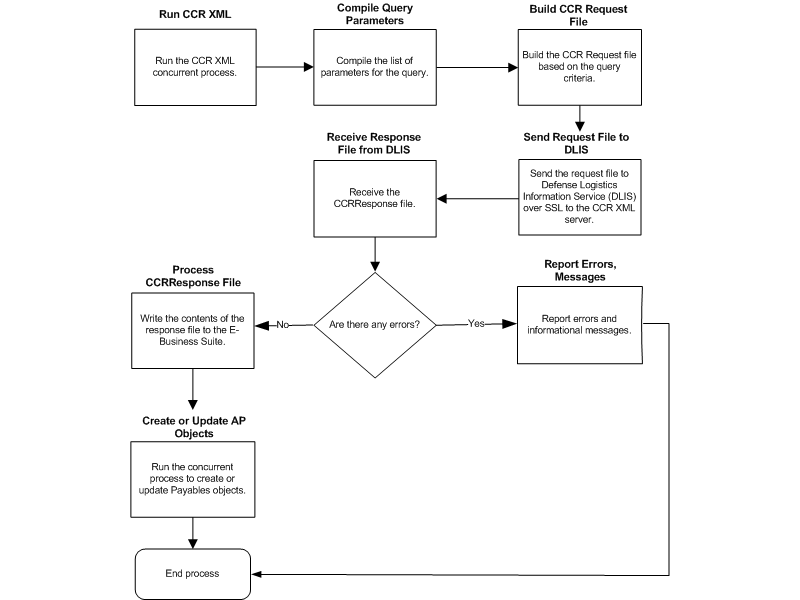Central Contractor Registration (CCR)
Overview
The Office of Management and Budget (OMB) requires agencies to use information contained in the CCR as the source for making payments to vendors, with certain exceptions. Current and potential government vendors are required to register in CCR in order to be awarded contracts by any federal agency. Vendors provide basic information relevant to procurement and financial transactions.
The CCR process provides agencies to import and automatically process data pertinent to the Core financial system. This includes:
-
Automatically update mandatory payee information in existing vendor records to reflect the relevant changes contained in the daily updates
-
Accommodate the data definitions, such as data types, field names, and field lengths, used in the CCR for all fields common in both the CCR and the core vendor file
-
Prevent users from manually updating the relevant data fields whose source must be the CCR for vendors required to register in the CCR
In addition, the CCR process maintains payee (vendor) information to support obligation, accounts payable, and disbursement processes.
CCR Integration with Oracle Payables
The CCR integration in Oracle U.S. Federal Financials creates or updates these Payables objects with data from CCR:
-
DUNS Number in the Supplier Sites window
-
Taxpayer identifier in the Suppliers window
-
Country and address fields and bank accounts information in the Supplier Sites window
-
Bank branch number and branch type in the Banks window
-
Account number, account type, and supplier assignment in the Bank Accounts window
The information in the CCR fields cannot be modified.
In the Supplier Sites window, users can navigate to the View CCR Supplier Details window from the Tools menu.
Payables also checks a CCR vendor’s registration at certain points during the invoicing and payment processes.
The following table describes how the CCR Vendor Registration status impacts Payables functionality.
| Vendor’s CCR Registration | Third Party Agent’s CCR Registration | Invoice Creation (AP) | Invoice Validation (AP) | Payments (AP) |
|---|---|---|---|---|
| Active | None used | An invoice can be created. | An invoice can be validated. | A payment can be processed. |
| Expired or Inactive | None used | An invoice can be created for an obligation. | An invoice cannot be validated. An expired registration hold is applied. | A previously validated invoice cannot be paid for selected payment. |
| Active | Active | An invoice can be created for the CCR vendor. | An invoice can be validated for the CCR vendor. | A payment can be processed for the third party agent. |
| Expired or Inactive | Active | An invoice can be created. | An invoice cannot be validated. An expired registration hold is applied. | A previously validated invoice cannot be paid for selected payment. |
| Active | Expired or Inactive | An invoice can be created for the CCR vendor. | An invoice can be validated for the CCR vendor. | A payment cannot be processed for the third party agent. |
CCR Integration with Oracle Purchasing
CCR and Purchasing are integrated as:
-
Purchase order creation
A purchase order can be created for a site associated with an expired or inactive vendor.
-
Purchase order approval
Users cannot approve a purchase order for an expired or inactive vendor
-
Purchase order modification
Users cannot modify a purchase order for an expired or inactive vendor.
The CCR impacts on Purchasing are:
-
The Purchase Orders window checks the validity of the supplier site registration.
If the supplier site registration is valid, the document can be submitted for approval and purchase orders can be approved in the Purchase Order Approval Workflow window.
-
The Import Standard Purchase Orders checks the validity of the supplier and supplier site when importing approved purchase orders.
If the supplier site registration is invalid, the program records the exception in the log file.
-
The Create Releases Process verifies the validity of the supplier registration when the release generation method is automatic release.
If the supplier registration is invalid, the corresponding releases cannot be set to Approved.
The following table describes how the CCR Vendor Registration status impacts Purchasing functionality.
| Vendor’s CCR Registration | Third Party Agent’s CCR Registration | Obligation (PO) |
|---|---|---|
| Active | None Used | An obligation can be created. |
| Expired or Inactive | None Used | An obligation can be created but not approved. |
| Active (domestic, foreign) | Active | An obligation can be created. |
| Expired or Inactive | Active | An obligation can be created but not approved. |
| Active | Expired or Inactive | An obligation can be created. |
CCR Process Flow, First Time Use Diagram
These diagrams show the CCR process as described in CCR Process, First Time Use.
CCR Process Flow, First Time Use

CCR Process Flow, First Time Use (continued)

CCR Process Flow Daily Updates Diagram
The diagram below shows the CCR process as described in CCR Process, Daily Updates.
CCR Process Flow, Daily Updates Diagram

Central Contract Registration
Features
-
CCR Data Load Process
-
CCR Extract File Request Set
-
CCR Vendors Search page
-
Add DUNS Number page
-
Payables Assignments page
CCR Process, First Time Use
The CCR Process, First Time Use includes:
-
Download the CCR extract files for processing from the Defense Logistics Information Service (DLIS) website.
For the first time use, the latest monthly refresh file, daily update files since the last monthly file up to the current date should be downloaded.
-
Extract the zip file and declassify it, depending on agency policy.
-
Move the extracted files to a location accessible by the Oracle E-Business Suite.
Note: Add a .dat extension to the file, but do not change the file names.
-
Apply the upgrade patch having CCR Integration.
-
Run the Supplier Merge process to combine duplicate suppliers.
Note: For the supplier merge, you can do the following:
-
Replace Third Party: This would not have any accounting impact on existing transactions but new transactions would use new third party supplier liability account. There is no real audit trail between new supplier and existing transactions.
or
-
Transfer Account Balance: This is the recommended option as this would provide an audit trail. For entries after the merge date for the old third party and party site, all the entries will be reversed and rebooked with the new third party and new site. Thus there is no impact on Budgetary control as the reversal and rebooking will have a net zero impact on the expenditure. The net impact on budgetary accounting entries for the expenditure is zero. For the change in liability accounts there is no impact on budgetary accounting
-
-
In the CCR Vendors Search page, users can add a new DUNS number for each CCR vendor with which the agency contracts by clicking Add New DUNS.
A new DUNS number is created with the status Unknown.
-
Run the CCR Data Transfer process for the latest monthly file to load CCR data into the E-Business Suite.
The registration status is updated to Active, Expired, Deleted, or Unregistered when the CCR Data Load Process is run.
-
In the CCR Vendor Search page, find each DUNS number previously entered.
The CCR Vendor Search page displays:
-
DUNS number and any associated DUNS+4 numbers
-
CCR Data for each DUNS/DUNS+4 number
-
-
In the Payables Assignments page, assign a DUNS/DUNS+4 number to suppliers and supplier sites.
If a new supplier and site are required for a DUNS/DUNS+4 number, enter the operating unit for the new site. This step is required to create or update Payables.
-
Click Apply in the Payables Assignments window to run the CCR Data Processing process that maps the DUNS/DUNS+4 number to Payables objects including suppliers, supplier sites, bank branches, and bank accounts.
-
Determine if there are daily files to process.
If there are no daily extract files to process, the first time use process is complete. If there are daily extract files to process, continue with the next step.
-
Run the CCR Extract File request set to process the oldest daily file and continue through each daily file from oldest to newest.
This ensures that every vendor record is current.
-
Review the output file from the CCR Data Transfer process for new DUNS+4 numbers.
-
In the CCR Vendor Search page find the new DUNS+4 numbers.
-
In the Payables Assignments page, assign the new DUNS+4 number to a supplier sites.
-
In the Payables Assignments page, run the CCR Data Processing process to create or update Payables.
-
Determine if more daily extract files must be processed.
If there are more files to process, run the CCR Extract File request set for the next oldest daily file. If not, the first time use process is complete.
CCR Process, Daily Updates
The CCR Process, Daily Updates includes:
-
Download the daily extract file from DLIS.
-
Extract the zip file and declassify it, depending on agency policy.
-
Move the extract file to a location accessible by the Oracle E-Business Suite.
Note: Add a .dat extension to the file but do not change the file name.
-
Run the CCR Extract File request set to process the daily file.
-
Review the output file from the CCR Data Transfer and the CCR Data Processing processes for new DUNS+4 numbers and determine if there are any new DUNS+4 numbers.
If there are no new DUNS+4 numbers, the daily uptake process is complete. If there are new DUNS+4 numbers, continue with the next step.
-
In the CCR Vendor Search page, find the new DUNS+4 numbers.
-
In the Payables Assignments page, assign the new DUNS+4 number to a supplier site.
CCR XML Process Diagram

CCR XML
Features
The CCR XML process includes:
-
CCR XML Process
-
Add DUNS Number page
-
Payables Assignments page
CCR XML Process Steps
The CCR Process, First Time Use includes:
-
Run the CCR XML concurrent process. For first time use and when adding DUNS numbers, this process is manual. For daily updates, this process is automated.
-
Compile the list of parameters for the query. Parameters for DUNS number are:
-
All for the complete list of CCR vendors used by the agency
-
Single for one particular DUNS number
-
New for all newly entered DUNS numbers
Note: CCR XML also supports queries by taxpayer number, social security number, CAGE code, registration status, and start or end date.
-
-
Build the CCRRequest file based on the query criteria.
-
Send the request file to DLIS over SSL to the CCR XML server using HTTP POST.
-
Receive the CCRRsponse file from DLIS.
-
Check the response file for errors.
-
Write the contents of the response file to the E-Business Suite.
-
Determine whether to call the iSetup APIs. For All, continue processing. For New or Single, end processing; the vendor administrator must assign these new DUNS/DUNS+4 numbers to Payables objects.
-
Report errors and informational messages.
The Records per Request parameter improves performance by breaking queries into multiple requests. For example, if users query CCR for 1,200 vendor records and set the Records per Request parameter to 500, Oracle U.S. Federal Financials segments the query into three requests to CCR.